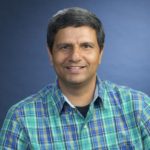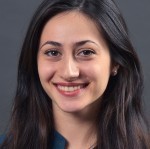
Physics Education Research (PER) Division provides a forum for the research on pedagogical techniques and strategies that will help students learn physics more effectively and help instructors to implement these techniques. This also includes the best scientific practices like active learning which will provide every student in a class an equal opportunity to learn. For more information on PER, the following resource is useful: https://www.aapt.org/aboutaapt/history/AAPT-History-PER.cfm
“The process of a physics course redesign: Integrating numerical modeling into an introductory physics laboratory”
Diana Sachmpazidi, University of Maryland
Abstract: Computation is integral to modern scientific practice, along with theory and experimentation. However, traditional physics curricula typically introduce computation at later stages of the program and often on its own without meaningfully tying it to physical concepts. Moreover, while there is a broad consensus among the scientific community on integrating computation into physics instruction, there is limited guidance on how to do that effectively. In this talk, I will document the process of a collective effort to redesign a calculus-based introductory physics laboratory course to incorporate numerical modeling. I describe the instructional design and document students’ and instructors’ attitudes toward the newly redesigned course. Despite some challenges, students identified numerical modeling as the most important and beneficial feature of the course. The computational tools allowed students to engage in more complex and realistic experiments than in conventional laboratories, which triggered their interest and kept them engaged in the task. Results from instructor interview data corroborate the positive perceived aspects of student attitudes towards the course.
Biography:
Diana Sachmpazidi is a postdoctoral researcher at the University of Maryland, College Park. Diana received her Ph.D. in Science Education/Physics at Western Michigan University in 2021. Her primary research focuses on departmental change, graduate education, and undergraduate student learning. Specifically, through two NSF-funded projects, she aims to understand team-based collaboration for instructional change and cultural change of program assessment within departments. Through her research, she also aims to understand the long-standing challenges in physics graduate education by focusing on the departmental context that students experience. Moreover, she studies undergraduate student learning in introductory physics labs that emphasize computational thinking. Diana is trained in and has experience in qualitative, quantitative, and instrument development methods.

“To teach or not to teach, that is the question.”
Qing Ryan, California Polytechnic University, Pomona.
Abstract: In order to investigate whether there are any differences between students who choose to become high school teachers versus those who do not, we conducted a survey in the Department of Physics at East China Normal University. East China Normal University offer teaching trajectory for undergraduates in physics department. Students on the teaching trajectory are pre-service teachers who are going to be middle school physics teachers after graduation. 266 undergraduate students responded to the questionnaire, and there are about equal number of men and women as well as who are on the teaching and non-teaching trajectory. Students’ self-efficacy and physics identity were compared between the teaching and non-teaching trajectory. Possible gender gaps were also evaluated in these measures. Male and female students’ self-reported motivation in choosing the physics major and the teaching career were also compared for students on the teaching and non-teaching trajectory. In this talk, I will discuss the findings and talk about possible implications of the study.
Biography:
Dr. Qing Ryan is an Associate Professor at the department of Physics and Astronomy at California Polytechnic University Pomona. She earned her PhD in Physics from the University of Minnesota Twin cities in 2013, focusing on Physics Education Research (PER). Then she worked as a postdoctoral fellow at the PER Group at University of Colorado Boulder. Her research interest includes problem solving, assessment development and validation at both the introductory and upper-division level, student difficulties in upper-division E&M, understanding performance gaps in introductory physics, self-efficacy and physics identity for pre-service physics teachers.

Please look below for detailed schedule.
|
Date/Time: |
Abstract Number: ANPA2023-N00091 Presenting Author: Diana Sachmpazidi (Invited) Presenter's Affiliation: University of Maryland Location: Virtual Presentation Show/Hide Abstract Computation is integral to modern scientific practice, along with theory and experimentation. However, traditional physics curricula typically introduce computation at later stages of the program and often on its own without meaningfully tying it to physical concepts. Moreover, while there is a broad consensus among the scientific community on integrating computation into physics instruction, there is limited guidance on how to do that effectively. In this talk, I will document the process of a collective effort to redesign a calculus-based introductory physics laboratory course to incorporate numerical modeling. I describe the instructional design and document students’ and instructors’ attitudes toward the newly redesigned course. Despite some challenges, students identified numerical modeling as the most important and beneficial feature of the course. The computational tools allowed students to engage in more complex and realistic experiments than in conventional laboratories, which triggered their interest and kept them engaged in the task. Results from instructor interview data corroborate the positive perceived aspects of student attitudes towards the course.
|
||||||
|
Date/Time: |
Abstract Number: ANPA2023-N00088 Presenting Author: Qing Ryan (Invited) Presenter's Affiliation: California Polytechnic University Pomona Title: To teach or not to teach, that is the question Location: Virtual Presentation Show/Hide Abstract In order to investigate whether there are any differences between students who choose to become high school teachers versus those who do not, we conducted a survey in the Department of Physics at East China Normal University. East China Normal University offer teaching trajectory for undergraduates in physics department. Students on the teaching trajectory are pre-service teachers who are going to be middle school physics teachers after graduation. 266 undergraduate students responded to the questionnaire, and there are about equal number of men and women as well as who are on the teaching and non-teaching trajectory. Students’ self-efficacy and physics identity were compared between the teaching and non-teaching trajectory. Possible gender gaps were also evaluated in these measures. Male and female students’ self-reported motivation in choosing the physics major and the teaching career were also compared for students on the teaching and non-teaching trajectory. In this talk, I will discuss the findings and talk about possible implications of the study.
|
||||||
|
Date/Time: |
Abstract Number: ANPA2023-N00089 Presenting Author: Umesh Silwal Presenter's Affiliation: Department of Physics and Optical Science, University of North Carolina at Charlotte Location: Virtual Presentation Show/Hide Abstract Active learning strategies, such as hands-on activities, group work, discussions, and technology-assisted instructions can help students connect abstract physics concepts to real-world applications making them more interesting and relevant. These strategies also help to break down stereotypes about the subject and enhance critical thinking, problem-solving, and collaboration skills which are valuable to students in any career path.
In this study, effectiveness of implementing active learning strategies were assessed using students' end-of-semester course evaluations and final grades. Students deep learning, classroom engagement, and final grade were observed significantly improved with active learning instructions in comparison to the traditional teaching method used for the same physics course in the previous semester.
|
||||||
|
Date/Time: |
Abstract Number: ANPA2023-N00090 Presenting Author: Ganga P Sharma Presenter's Affiliation: Fairmont State University Title: Improving Teaching in Physics Courses Using SCALE-UP Pedagogies Location: Virtual Presentation Show/Hide Abstract Students can most effectively learn physics courses when they actively engage in learning activities. Inquiry-based learning in a studio-like technology-rich setting is the most salient feature of SCALE-UP model of instruction. The successful implementation of this learning environment over 500 colleges and universities across the US and around the world, including Massachusetts Institute of Technology (MIT), has shown significant results in students’ learning outcomes and retention, including improvements in attendance rates and grades as well as enhancements in problem-solving skills and overall understanding. This talk summarizes approaches for improving teaching and learning in physics courses in the SCALE-UP style.
|
||||||
